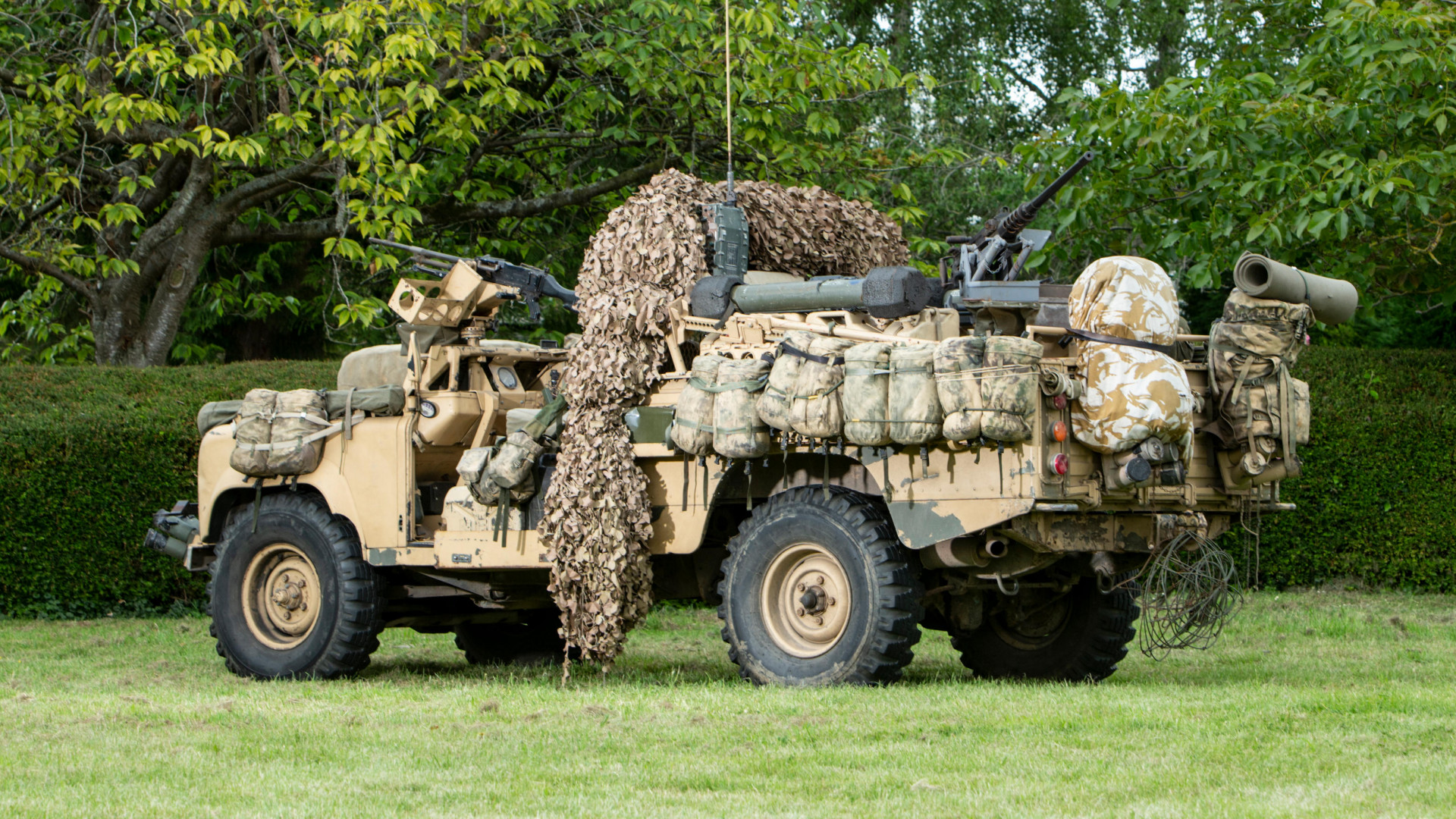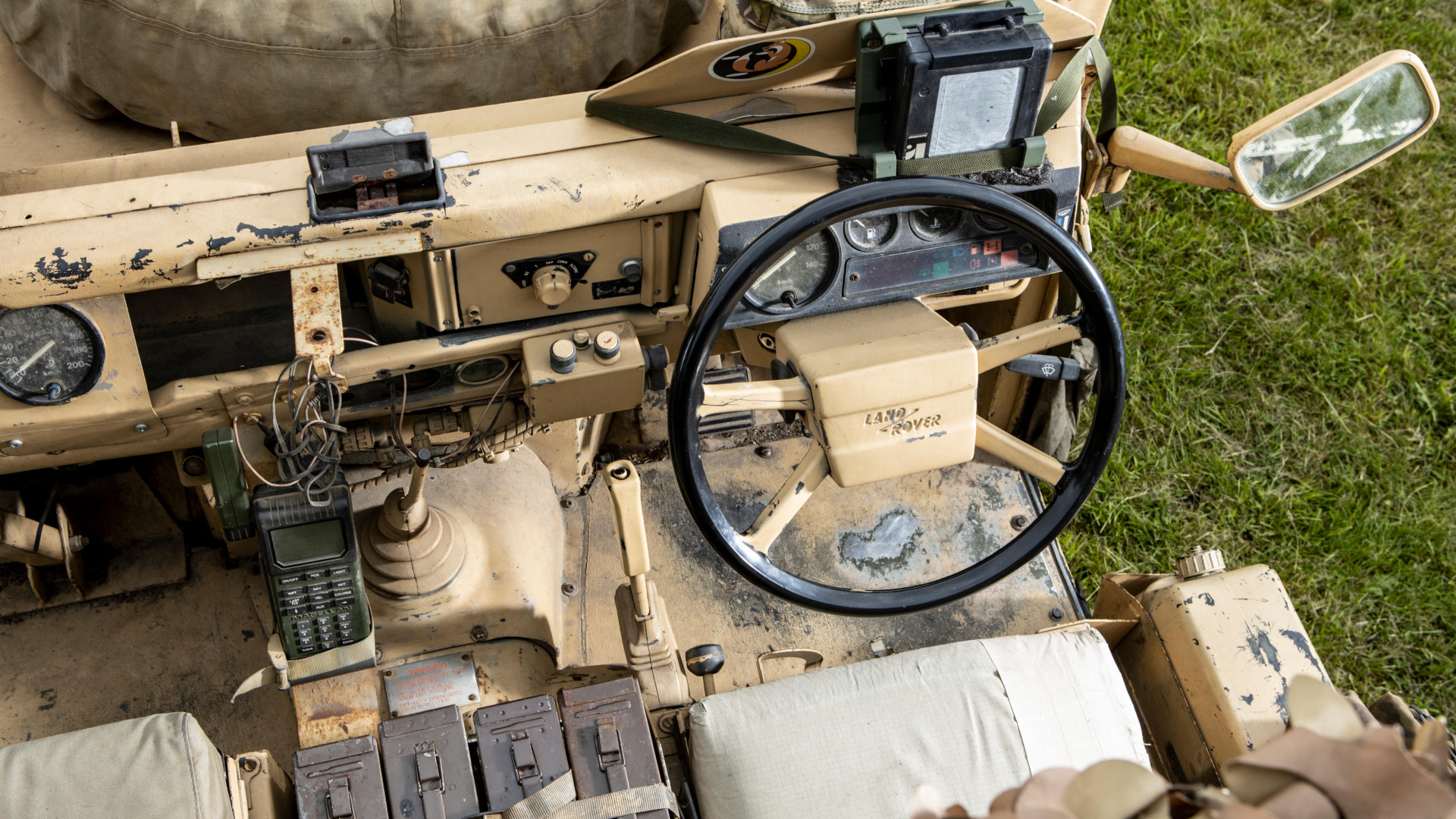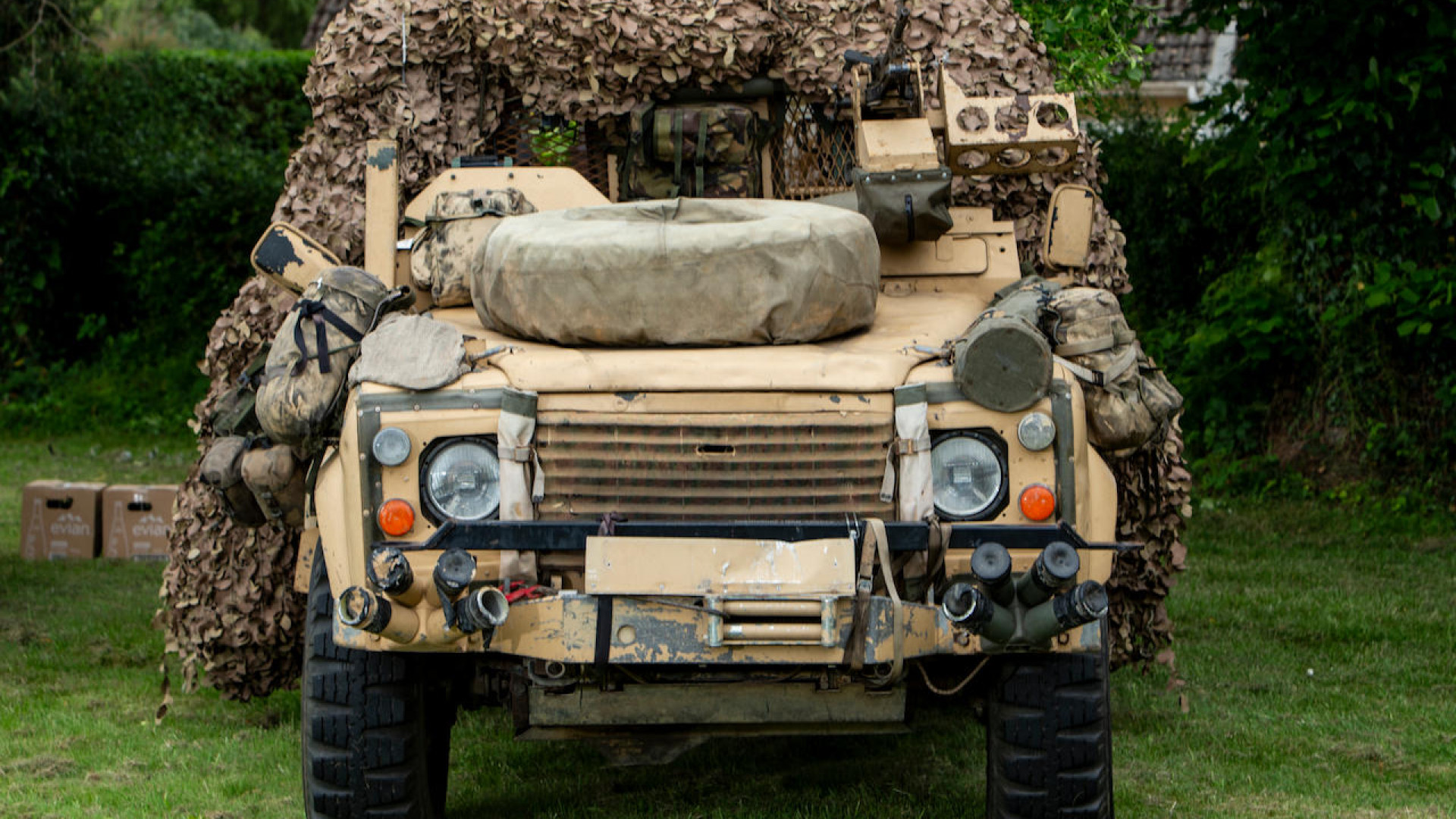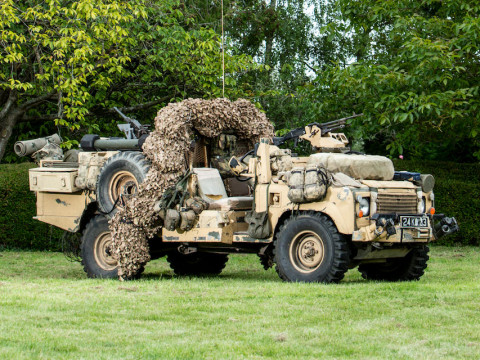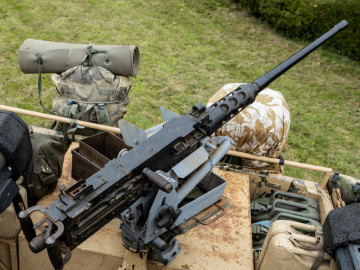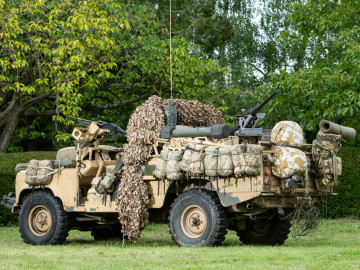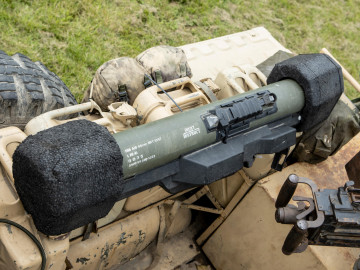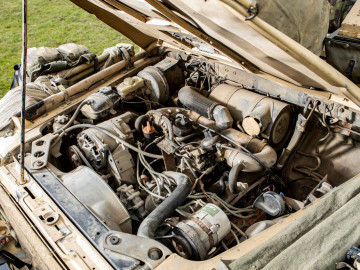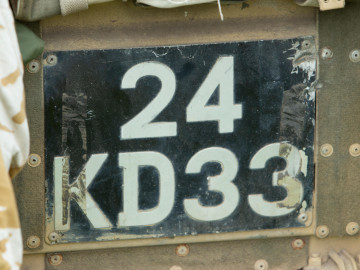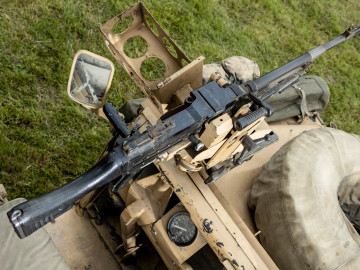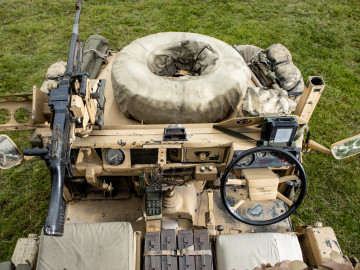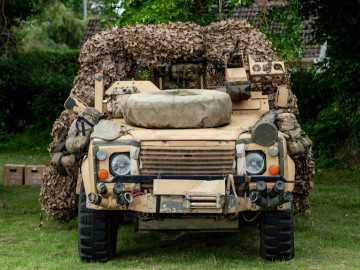SAS LRPV - Desert camo'
One-Ten Hi Cap: 3.5 Ltr V8 SAS Special Operations Vehicle (1985)
24 KD 33 is one of 33 such vehicles prepared to the exacting requirements of the SAS by Glover Webb and delivered to Hereford in November 1985. It was based up the heavy duty One-Ten Hi Cap pick-up powered by a Rover 3.5-litre V8 engine and manual gearbox. But nothing is so straightforward for the military. The vehicle's identification plate confirms this to be a "TRUCK-UTILITY-SAS-4x4-LAND-ROVER-110-V8-HEAVY-DUTY". We hold two such vehicles, thought to be the only two remaining in private hands.
The batch arrived in Hereford dressed in regular NATO green with windscreens attached. The latter were soon removed and once things kicked off in the Middle East the livery was immediately changed to the now familiar sand colour. Notwithstanding these two colours, these vehicles inevitably acquired the familiar nick-name by troopers; "Pinkies". Being named after the original Series IIA SOV's that they were replacing (see our exhibit MIL 02).
The V8 was extremely thirsty, but operationally acceptable as, by now, operations would typically be backed by airborne support by which fuel could be delivered to replenishment RV's mid operation. For prolonged sorties this extended the operational range beyond the modest 200 miles allowed by the twin under-seat fuel tanks. By comparison, the original Pinkies from the 60's offered in excess of 1,000 mile range unsupported! However in the hostile terrain of the dessert and having regard to its load, the power offered by the V8 outweighed the vehicle's limitation in range.
It seems counter-intuitive to speak of safety concerns when mentioning the SAS, but incorporation of a roll bar behind the driver was deemed appropriate. There was also a full suite of 'get you out of scrapes' equipment. Bigger tyres (9.00 x 16s), two spare tyres were carried, a heavy duty winch up front, sand ladders, pioneer tools and the like. An 'old technology' sun compass continued to be fitted should the new Magellan GPS set fail. A full description of the operational pay load and weaponry can be found under our other exhibit - MIL 05 - follow the link below.
Most famously these vehicles were active on Operation Granby - the UK component of Operation Dessert Storm - in the first Gulf War. Much has been written of these exploits in authoritative novels written by SAS veterans. These vehicles remained the mainstay SAS patrol vehicle until the next batch of replacement special forces' Defenders were acquired in 1991 (exhibit MIL 06). We have tried to capture the spirit of an active Gulf War patrol unit in the manner in which we have kitted out and exhibited our two examples of this remarkable patrol vehicle.
If only they could talk to us ... what tales could they tell?
More InfoIn the mid '80's a number of trial vehicles were created for development jointly with the SAS as replacements for the 60's Pink Panthers which were by then getting long in the tooth, being 15 years old. SAS procurement was allowed to circumvent the tardy Ministry processes and it appears the Regiment worked directly with the specialist vehicle manufacturer, Glover Webb, to develop this incrredible variant of the 110 High Capacity Pick-Up body. (requisition number 85/86B017, Military contract number F.V.E.22B/695)
Eventually an order of 33 Glover Webb adapted 110's was settled on and they started to arrive in Hereford from November 1985. These SOV's (Special Operations Vehicles) arrived in Nato Green livery. It was for the Regiment to repaint those that needed Dessert cam', as in the case of our two examples. But the colour was not the defining factor. Such was the affection shown to the very original LRPV's that even these new usurpers of the role were called 'Pinkies' by those that drove them. You can understand the attraction of the term - the official model nomenclature stamped on the body plate was a rather less than snappy; "TRUCK-UTILITY-SAS-4X4-LAND-ROVER-110- V8-HEAVY-DUTY"
The SAS have never felt constrained in leaving their equipment in showroom condition. In addition to a paint job, soon after delivery these vehicles invariably lost the windscreen that was part of the original delivery specification.
Most of the equipment was demountable so that they could be used for load carrying duties when not engaged on patrol operations. The 110's were fitted with a powerful 3.5 Ltr V8 engine. These thirsty units seem counter-intuitive to their deep penetration role in the field. However, by then the basis of regular operation logistics involved regular replenishment of fuel and stores by Helicopter. A 200 mile range for a fully loaded V8 was well within scope, all be it to achieve this those in the front seats were sitting on top of two specially designed fuel tanks. Not sure that is where most of us would wish to be sitting in a fire fight! This more modest range contrasts remarkably to the 1,000 mile plus range of the original LRPV Pink Panthers who often operated totally unsupported for entire sorties deep into hostile territory,.
The vehicles were given chunky 9.00x16 tyres to give improved ground clearance and a front mounted Superwinch 8552 for self recovery. Provision was made for a front facing GPMG and a post mounted heavy 50mm Calibre machine gun facing rearwards. The mesh behind the driving position provided useful hanging opportunities for readily accessible equipment. Notwithstanding that GPS was available to the military by the mid-80's, these vehicles would typically have a sun-compass attached to the dash.
Then all this would typically be topped off with copious rolls of camouflage netting that could be deployed swiftly when the patrol was holed up or at the first sound of an approaching spotter craft, in the air or on land. We have tried to capture the spirit of an active unit in the manner in which we have kitted out our two SOV's.
Much as they tried to cover the angles, not even the SAS thought of everything. There are documented instances occurring during the Gulf War of the crew having to light fires under the vehicles in the sleet and snow of the desparately cold dessert nights to prevent the diesel freezing in the fuel pipes.
Exact details of the exploits undertaken by this remarkable workhorse of our Special Services will remain beyond the knowledge of we common-folk. However they were most famously deployed in 1991 as part of Operation Granby (the repatriation of Kuwait - the first Gulf War). In order to avoid the provocation to Arab allies of the Israel's entering the conflict, when scud missiles started landing onTel Aviv, a number of these vehicles were sent into Iraq's Western Dessert on sorties to track down Saddam Hussein's widely disbursed mobile scud missile launchers. Working in an area of thousands of square miles (termed 'Scud Alley") they not only knocked out the scud launchers with their Milan anti-tank missiles but, in addition to spreading general mayhem and disruption, they put pay to key communication bunkers and relay stations that they found along the way.
On one reported occasion following close an engagement with the enemy one of these vehicles brought home a captured Iraqi artillery officer who had on him important Iraqi battle plans. Their pivotal and 'Boys-Own' exploits captured the imagination of the British public back home and was further immortalised by a number of SAS authoritative novels in which the exploits of this campaign have been recounted by those on the ground at the time.
We hope our attempts to present our two SOV's in a fully loaded state captures the uniqueness of these remarkable vehicles. If only they could talk to us ... what tales could they tell?
Part of:
Defenders
Military Rovers
The Collection
Vehicle Owner: Land Rover Heritage Collection
Want to help take a look at our get involved pages.
Know something about this vehicle contact us.
